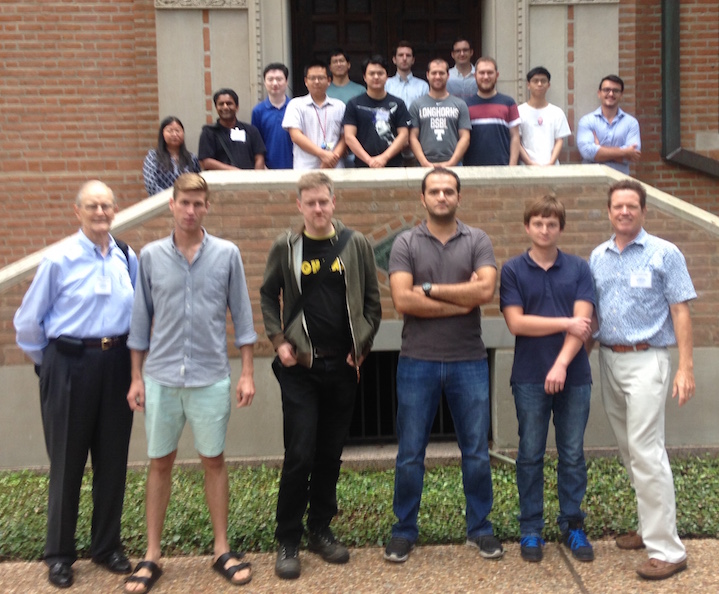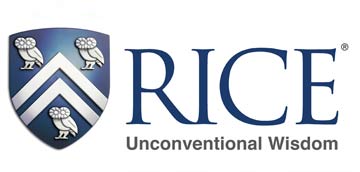SEG 3D Seismic Processing Working Workshop Houston 2015- Land 3D
Contents
2015 Working Workshop Attendees
Overview
A working workshop to create processing results for Land 3D seismic data held on August 19-22, 2015. Working Workshops as opposed to “talking workshops” are meetings where the participants collaborate in small groups to develop new software code or to conduct computational experiments addressing a particular problem.
This workshop invited participants to create processing results on the small, open data, 3D land project (Teapot Dome 3D). Participants were encouraged to use their own proprietary or open software. Our goal was a final presentation describing the programs, parameters, and data (input and output) in sufficient detail so the results can be reproduced after the workshop. Participants were encouraged to download the Teapot Dome 3D data before the workshop.
The photograph at the top of this post shows some of the 25 participants from 16 organizations who participated in the event. They were from diverse backgrounds including students, post docs, academic staff, faculty, early career professionals, and senior professionals.
A GitHub repository was established to share processing scripts. Final presentations were made in a Lightning talk (5 minute presentation) session on the final day. Presentations were saved and are publicly available.
Agenda
Wednesday – Optional informal Tutorials
- Install software and Teapot Dome data
Thursday – Working started
- Introductions, team formation, team work Lunch and learn – SeaView Team work, team check in
Friday – continue work sessions
- Team work, check in, workshop dinner
Saturday - wrap up and presentations
- Create presentation, lunch, lightning talks
Some final presentations
Bjorn Olofsson was invited to on Thursday to make a lunch and learn presentation on SEAVIEW the viewer from the OpenSeaSeis package. Seaview supports multiple seismic formats including SeaSeis, SEGY, SU, and Madagascar. Bjorn described issues related to visualization including how to handle aliasing. See Bjorn’s presentation and the full distribution of his demo.
Huang, Liau, Yu described the workshop effort to edit bad traces on the Teapot Dome survey. They used the Python API in IPython notebooks to access the data. They used the Mayavi Python library for 3D visualization. They observed three types of noise and developed a Python script to build a mask to edit one type of noise traces. The presentation is available here.
Merzlikin and Cvetkovic presented results using diffraction imaging and oriented filtering on the teapot dome project. They estimated a 3D dip field and used it for 3D diffraction and structure oriented smoothing. The presentation is available here.
Worthy-Blackwell and Staal worked on Velocity interpolation and NMO. They interpolated the commercial velocity field using scipy.interpolate.Rbf and applied it to a small subset of the data using sfbinint3 and sfnmo.
Yangkang Chen applied noise suppression to the post stack volume and evaluated results on output and difference volumes.
Bill Symes applied a basic processing sequence with Seismic Unix. He approximated the processing sequence in Excell’s processing report from the original processing. His sequence was tpow, decon, agc, nmo, and stack. No surface consistant decon or scaling is available in SU, so he used single trace processing. He showed incremental improvement at each stage on midpoint gathers and stacks. He also checked for residual moveout on CMP gathers and made updates to the velocity field. This was the most complete processing sequence produced at the workshop. His presentation is available here.
List of archived final presentations
Summary
In summary, the workshop was attended by a good mixture of academics and professionals with a broad range of experience. Turnout for the optional tutorial day was much larger then expected, about 20. Most attendees used Madagascar, but the most complete processing sequence was applied using Seismic Unix. Madagascar and Seismic Unix were both developed as a platform for university research and many basic processes are missing. Applying a full processing sequence to 3D land data with these systems is a challenging task. Unfortunately nobody used a commercial processing system to help guide improvements to these academic systems. SeaView shows promise as a viewer to help explore your data. Participants enjoyed the opportunity to learn, contribute and network.
Let’s do it again next year using the Stratton 3D Land seismic survey! Contact me at seismic.working.workshop@gmail.com to help organize the event.
Supporting Organizations
Department of Computational and Applied Mathematics
Rice University




